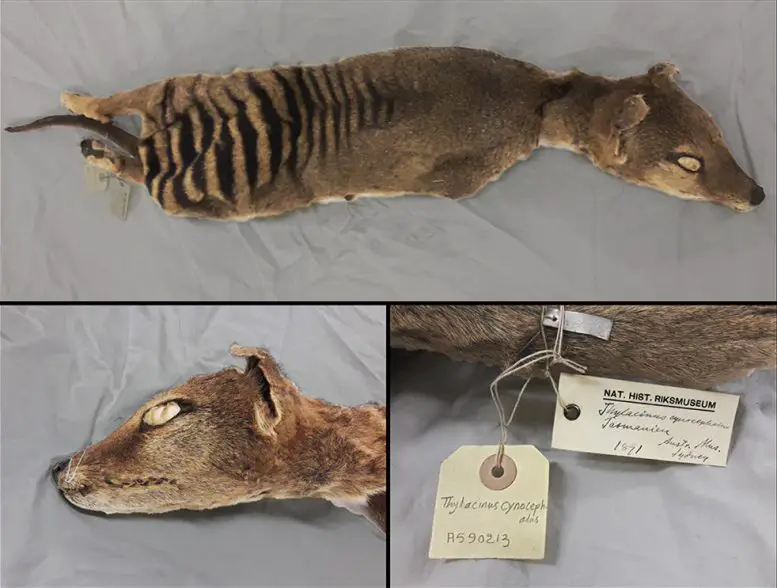Tags: Rna recovered from an extinct species, Tasmaniam tiger.
A groundbreaking study has achieved the isolation and sequencing of century-old RNA molecules extracted from a preserved Tasmanian tiger specimen, stored at room temperature within a museum collection. This groundbreaking feat marks the inaugural reconstruction of transcriptomes for both skin and skeletal muscle tissues from an extinct species. The implications of these findings extend to global endeavors focused on the revival of extinct creatures, including the Tasmanian tiger and the woolly mammoth, as well as research into RNA viruses associated with pandemics.

The Tasmanian tiger, scientifically known as the thylacine, once inhabited vast regions of the Australian continent and the island of Tasmania. This remarkable apex carnivorous marsupial met its tragic end with the arrival of European settlers, who classified it as an agricultural nuisance. In 1888, a bounty of £1 per fully grown thylacine killed was offered, sealing the fate of this unique species. The last confirmed Tasmanian tiger, residing in captivity, breathed its last in 1936 at the Beaumaris Zoo in Hobart, Tasmania.
Current conservation efforts have centered on the Tasmanian tiger due to the preservation of its natural habitat in Tasmania, offering a potential avenue for the restoration of ecological balance disrupted after its extinction. However, the successful resurrection of a living Tasmanian tiger hinges not only on understanding its genetic code (DNA) but also on unraveling the dynamics of tissue-specific gene expression and gene regulation, both of which are discernible through the study of its transcriptome (RNA).
Emilio Mármol, the lead author of a study recently published in the Genome Research journal, underscores the complexity of resurrecting iconic species like the Tasmanian tiger or woolly mammoth. He emphasizes the necessity of in-depth knowledge regarding the regulation of both genome and transcriptome for these renowned creatures, a field of study now unfolding. This research was conducted by scientists at SciLifeLab in collaboration with the Centre for Palaeogenetics*, a joint initiative involving the Swedish Museum of Natural History and Stockholm University.
RNA molecules recovered from the Tasmanian tiger
In a pioneering scientific endeavor, researchers have successfully sequenced the transcriptome of skin and skeletal muscle tissues from a remarkably well-preserved 130-year-old Tasmanian tiger specimen. This specimen, stored at room temperature within the Swedish Museum of Natural History in Stockholm, has yielded unprecedented insights. The study has unveiled tissue-specific gene expression patterns closely resembling those found in contemporary marsupial and placental mammals.
The transcriptomes retrieved from this ancient specimen exhibited remarkable quality, enabling the identification of protein-coding RNAs specific to muscle and skin tissues. Furthermore, the study contributed to the annotation of previously undiscovered ribosomal RNA and microRNA genes, aligning with recommendations from MirGeneDB.
Marc R. Friedländer, Associate Professor at the Department of Molecular Biosciences at Stockholm University and SciLifeLab, emphasizes the significance of this achievement: “This is the first time that we have had a glimpse into the existence of thylacine-specific regulatory genes, such as microRNAs, that became extinct over a century ago.”

This groundbreaking research not only paves the way for fresh perspectives on the extensive repositories of specimens and tissues housed in museums worldwide but also holds promise for uncovering and sequencing RNA molecules yet to be explored.
Love Dalén, Professor of evolutionary genomics at Stockholm University and the Centre for Palaeogenetics, envisions broader horizons: “In the future, we may be able to recover RNA not only from extinct animals but also from RNA virus genomes, such as SARS-CoV2 and their evolutionary precursors, residing within the preserved skins of bats and other host organisms found in museum collections.”
The authors of this study express their excitement for future interdisciplinary research endeavors, uniting genomics and transcriptomics to usher in a new era of palaeogenetics transcending the boundaries of DNA analysis.